Pentax Optio WP – Waterproof Digital Camera Review
Pentax Optio WP – Waterproof Digital Camera
Surely it's not? It doesn't look like it is? That's the response Jay Werfalli got when he dropped this five megapixel camera into his friend's fish tank.
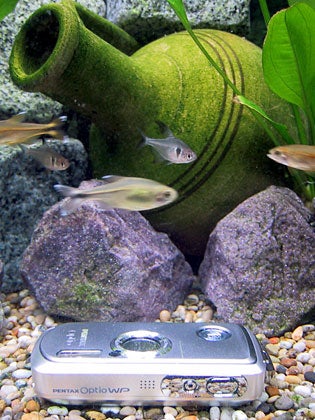
Verdict
Key Specifications
- Review Price: £192.00
I can’t quite believe that it’s been almost four years since I was introduced to the Optio 330, Pentax’s first point and shoot digital camera. Back then I was working for one of the UK IT rags, but I distinctly remember that I was impressed with the compact stainless steel metal body which felt very solid and durable. Fortunately, with the five megapixel Optio WP I have in my hands now, Pentax has stuck with that approach to solid design. Despite the fact that much of the casing is plastic, the WP is rigid and free from those unnerving creaking sounds that usually result when camera bodies built with cheaper, thinner, and more flexible plastics are handled.
There is a reason for this solidity. A reason requiring that the build quality meets certain standards. What am I taking about? Well, if you haven’t guessed from its name, the WP is waterproof and the standard it conforms to is the JIS (Japanese Industry Standard) Class 8, equivalent to the IEC’s (International Electrotechnical Commission) IEC 60529 IPX8 standard.
In both cases, the important figure is the number eight. This denotes the level to which the WP is protected from the ingress of water. Class 8 (IPX8) basically denotes that the product is tested to withstand the effects of continuous immersion in water for a specific time and depth as agreed by the standards agency and the company. In essence, the WP passes Class 7 (IPX7) in that it can be operated underwater to a depth of one metre for 30 minutes. However, thanks to the WP’s rubber sealed, double locking battery/memory card latch and another 50cm of depth during tests, this little camera hits Class 8.
So what does this mean to you and me? Well, a digital camera that can withstand real submersion should make it a hit with the outdoor types among us. Whether you’re on the beach, kayaking, jet skiing or snorkelling, the WP should be able to take the punishment. Of course, I had to put these waterproof claims to test, so what better way than dunking it in a fish tank.
At first, I have to admit that I was a little apprehensive. Unlike Pentax’s square-shaped, ruggedised, Class 7 Optio 43WR, the WP looks very much like a “normal” digital camera. Nothing about its design actually looks waterproof, but behind the slender and elegant two-tone body the buttons are fully sealed and the zoom lens is housed behind a watertight circular window that somewhat reminds me of a ship’s porthole.

Doubts aside, in it went, and it wasn’t long before my trepidation turned into full confidence. While it wasn’t easy capturing the shots displayed here, a combination of using the 10 second (or two second) self-timer and some luck, plus the Underwater mode and the rather nifty tracking AF function – part of the Sport and Pet modes – helped a lot. This is a sensory mode that monitors and follows changes in movement in order to keep the subject in focus, and in practice I found that it locked on pretty accurately. As for Pet mode, this is a delightful one that tweaks the WP’s exposure settings to take into account the colour of your pet’s coat, be it white, grey/mid-tone, or black. So as to not annoy dog or cat owners, Pentax has even used a specific icon for each animal. Cute, but where’s the icon for my Iguana?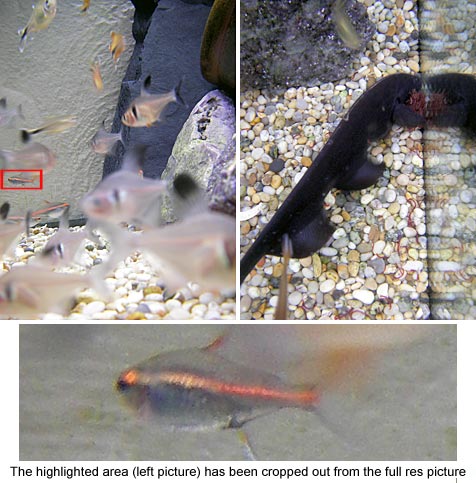
More seriously, the WP coped very well under water and sub-aqua operation had no deleterious affects. The image quality was actually reasonably sharp and colours where reproduced well, despite the light bending watery environment. Detail is not quite up to that of the air breathing world, but it’s far better than the results I’ve obtained from those disposable underwater cameras. I’ll also add that the water in the fish tank was crystal clear and very still, and I’d imagine that taking pictures in our Worlds’ not so clean seas could result in murkier results. That said, Pentax include an Underwater mode that brings out the blueness of the sea for that added bit of vibrancy. The other point I should make, if you haven’t already noticed from my first picture, is the fact that the WP doesn’t float so be sure to keep that hand strap wrapped around your wrist before you wade in.
As a point and shoot camera outside the aquatic world, the WPs handling, performance and image quality are all rather good, plus there’s plenty of features to keep the amateur photographer occupied.
The small and slim dimensions – 102 x 51 x 22mm (WxHxD) – make it a very pocketable compact, whereas all of the controls can be operated with just your thumb and forefinger. I’m not really a fan of badly positioned tripod mounts and the one here has been shifted right over to one side, although I doubt the WP’s 135g of weight will put too much strain on the screw hole. That said, the offset balance could make the WP more sensitive to vibrations especially when using the Night, Candlelight and Fireworks modes where the exposure times can reach up to four seconds.
There’s no optical viewfinder either, but the 2.0in LCD monitor is a jump up from the company’s Optio 43WR which featured a 1.6in screen. However, the resolution remains the same at 85,000 pixels which means the display isn’t quite as fine. Nonetheless, it refreshes at a flicker-free rate which is always good to see, plus its low-reflection and backlighting system make it a little easier to view outdoors on sunny days.
In terms of features, the mode palette as Pentax likes to call it, makes selecting the available icons very easy. Two of these palettes exist – one for recording pictures and the other pops up when the playback/preview button is pressed. 15 of these icons are displayed at one time, but in the recoding palette there’s another five icons which can be subsituted. The icons can be rearranged and they’re also coupled with brief descriptions as to what they’re intended for. If you want a little more information then pressing the green button will fire up a full descriptive sentence.
That’s not all the green button does, as it’s also used to fire up another mode, imaginatively called the Green mode. This is best described as a restore button, which basically resets the WP back to a standard combination of settings. You can also assign up to four functions to the green button as shortcuts. These can be chosen from the following list: recording image size, image quality, white balance, AF area, focus limit (quicker focusing for near and far subjects), exposure compensation, ISO sensitivity, sharpness, saturation and contrast. This level of customisation, along with the four-way control pad makes operating the WP a quick process, but only after you’ve spent some time to read the detailed manual.
![]()
Among the modes I’ve already mentioned, there’s a movie one that allows you to use the zoom across its optical range of 6.3mm to 18.9mm (equivalent to 38 – 114mm in a standard 35mm camera). You can’t however record at a resolution of 640 x 480, only at 320 x 240 and 160 x 120 pixels at either 30fps or 15fps. At 30fps the quality isn’t as high as, for instance, my Canon Ixus 30, but it’s nonetheless acceptable for short sequences complete with mono audio. You can also edit the movies right there within the camera. Not only can a frame from a movie sequence be saved as a still image, but a single movie can also be split into two, or two movies can be stitched together.
Other modes include adding voice memos to pictures, recording 10 seconds of audio prior to and after shooting a picture (Synchronous Sound Record mode), a recovery function for erased images, a post shot red-eye removal function, a panoramic stitching mode and an option to add frames to your pictures. The WP even doubles up as a timepiece complete with graphical clock face and an alarm. Modes of the more unusual yet specific variety include, Food (more ‘appetising’ saturation), Flower (softer outlines), and Museum (no flash). All in all, the WP is jam packed with features, some arguably gimmicky, but there’s plenty to keep you occupied. The only really downer is that it lacks aperture and shutter priority, but then that’s not uncommon with point and shoot cameras.
Performance-wise, Pentax claims a 0.6 second ready-to-shoot start-up time, but that’s only when the flash and customisable start-up screen and sounds are turned off. In practice, with these all activated it was closer to 1.5 seconds which is still rather good. An impressive continuous shooting rate of 3fps is achievable but is only sustained until the buffer is full or the SD memory card’s capacity is reached, which ever comes first. I managed to fire off a total of seven shots in high speed mode (limited to 1280 x 960 pixels) before the WP’s buffer maxed out.
As for power, the rechargeable lithium-ion battery is a dinky affair that annoyingly (and a tad embarrassingly) slides into its compartment the wrong way. Basically, it needs to be keyed to prevent this. The stated battery life is good for 180 images with the flash used 50 per cent of the time, and it takes about 100mins for a depleted battery to reach full charge. There’s about 10.5MB of internal memory, and a 64MB SD memory card (image/movies capacities below) is provided in the box along with a software CD that includes ACDSee and QuickTime.
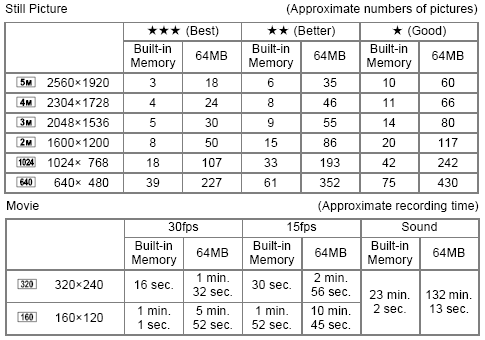
In use, I was highly impressed with the majority of images I captured. As we’ve seen the underwater shots were commendable, but outdoors the WP also produced well balanced shots, where colours looked vibrant and realistically saturated. The WP’s metering ensured that highlights were not blown out especially where brilliant whites and yellows were captured against darker backgrounds. Furthermore, if you’re unsure of the overall brightness balance of the shot you’re about to take, a live histogram is there to help, complete with those blinking red and yellow portions that indicate total whiteness and total blackness, respectively – ideal for judging fine adjustments to the WP’s exposure compensation (+/- 2 EV in 1/3 EV-steps).
The level of resolved detail was also good although at ISO 400 pixel noise was clearly evident. In my opinion, the WP’s macro mode is one of the best I’ve come across for a while. You can get as close as 1cm to the subject with the lens at its widest setting, and the resulting images are very impressive for such small optics. Even on the occasions when the flash fired it was throttled back to prevent overexposure. Chromatic aberrations were minimal too. Having said that, I did notice a strange artefact on one particular shot that I can only guess was a result of a droplet on the window that protects the optics. This in turn raises the possible need for a cover to prevent that window from getting damaged, particularly when you consider the sort of environments the WP will be taken to.
On the whole, though, I like this camera, but there is one gripe that comes about when the WP is hooked up to a PC over its USB 1.1 interface, which incidentally isn’t of the more common mini-USB variety. Basically, after connecting it, browsing/copying the images, and then disconnecting it, the WP refuses to return to the recording mode, and instead it remains locked into the playback/preview mode. The only way out is to switch the camera off and then on again.
Despite this grumble, the Optio WP has a lot to offer. This is a waterproof (not water resistant) camera that can take good images, has plenty of options and it’s reasonably priced at £192.50. Recommended, especially for those that enjoy shallow water sports…and confusing aquarium fish.
”’Verdict”’
Quite simply the Optio WP is one of only a handful of fully waterproof digital cameras currently on the market. It spares you the added expense of a separate waterproof housing and in terms of image quality it gives many “normal” compacts a run for their money, while blowing disposable underwater cameras clean out of the water. There are several niggles, but these are off-set by its ‘go anywhere’ practicality.
(table:wpspec)
”A range of test shots are shown over the next two pages. Here, the full resolution image has been reduced in size for bandwidth purposes, and a crop (taken from the original full resolution image at Adobe ImageReady jpg quality 60) follows each image in order for you to gain an appreciation of the overall quality. The next page consists of resized images (to Adobe ImageReady jpg quality 50) so that you can evaluate the overall exposure. For those with a dial-up connection, please be patient while the page downloads.”
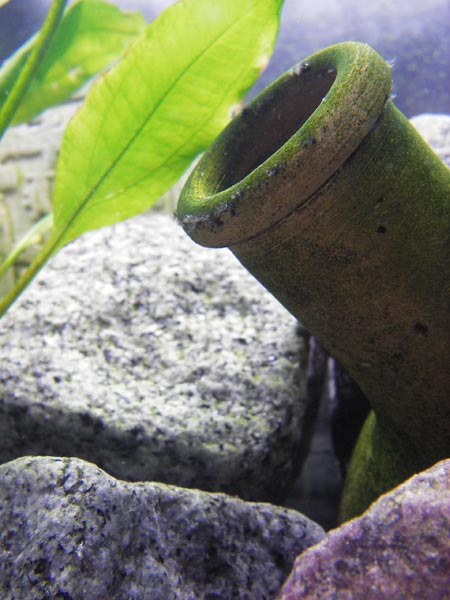
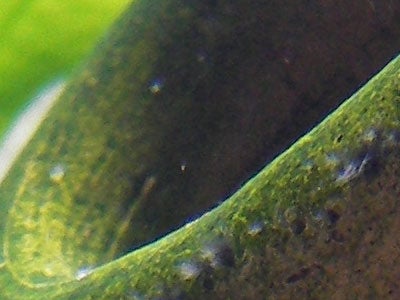
”’This image was taken under water in a fish tank. The quality is actually rather good and the colour balance and detail is retained despite the flourescent lighting and of course the liquid medium.”’
6.3mm (approx. 38mm equivalent), f3.3, 1/10sec, ISO 100.
—-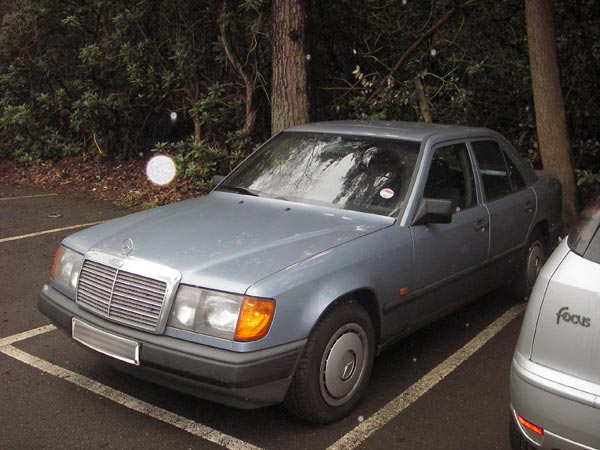
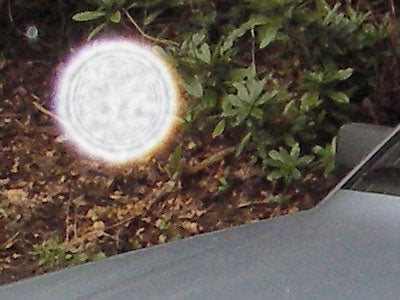
”’This shot demonstrates that a foreign body on the protective window covering the lens can result in some very strange artefacts. It was spitting with rain that day so I can only guess that a water droplet was the culprit. Feel free to email with any of your suggestions as to the physics behind this phenomenon.”’
6.3mm (approx. 38mm equivalent), f3.3, 1/30, ISO 100.
—-
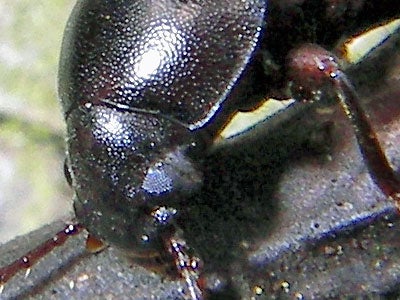
”’This macro shot of a 1cm local ground beetle (of the family Carabidae I believe) demonstrates that the WP’s macro facility is impressive for a compact digital camera. The flash fired too, and was impressively throttled back to minimise overexposure.”’
6.3mm (approx. 38mm equivalent), f6.6, 1/40, ISO 50, flash on, macro mode selected.
—-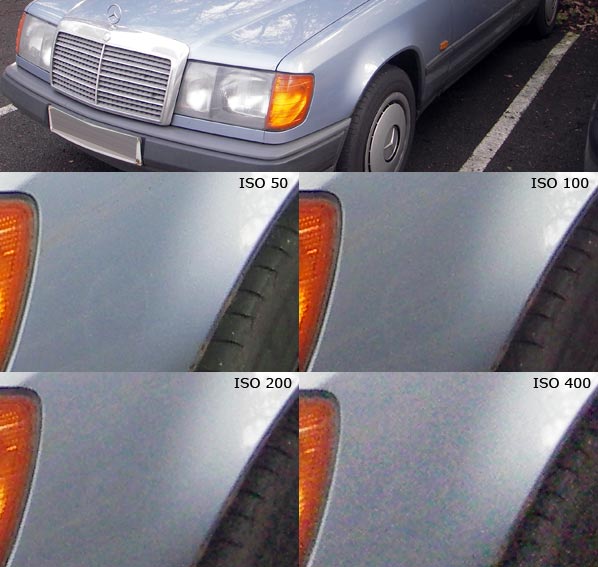
”’Here the same image has been taken at increasing sensitivies. At ISO 50 to 200 the image is pretty much noise-free. However, at ISO 400 there is distinct image noise.”’
”This page consists of resized images (to Adobe ImageReady jpg quality 50) in order for you to evaluate the overall exposure and the power of the WP’s zoom.”

”’The first two shots give you can idea of the 3x optical range of the WP’s lens. In the last shot the 4x digital zoom has been applied. Although difficult to tell here, the digital zoom applies heavy interpolation in order to increase the size of the image, resulting in low detail.”’
—-

”’This shot, taken with the flash on, reveals that subtle tonal differences have been metered well, and the output of the flash has been calculated accurately.”’
6.3mm (approx. 38mm equivalent), f3.3, 1/50sec, ISO 50, flash on)
—-
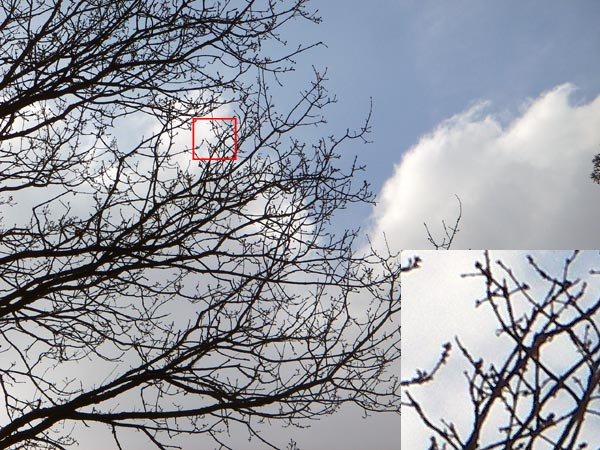
”’Chromatic aberrations (coloured fringing) are minimal. The inset picture is a crop-out from the original full resolution image.”’
18.9mm (approx. 114mm equivalent), f8, 1/250sec, ISO 50.
—-
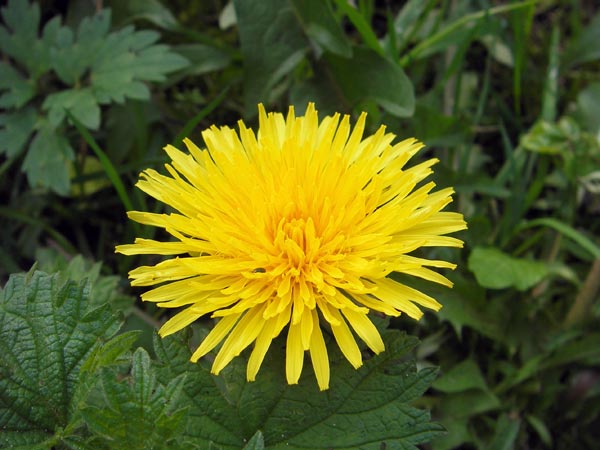
”’Colours are true to life and highlights are not blown out. The darker background still retains detail despite the extremes in contrast between light and shadow.”’
6.3mm (approx. 38mm equivalent), f3.3, 1/100sec, ISO 50.
—-
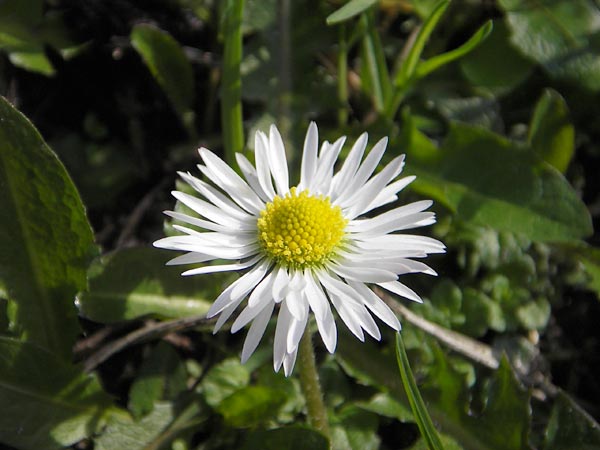
”’Again, the WP is quite at home outside of the water as this well exposed shot depicts. Whites in the flower are generally not washed out, and the background is pleasantly blurred. The AF has also ensured that the centre of the flower is sharp.”’
12mm (approx. 72mm equivalent), f3.8, 1/400sec, ISO 50.
Trusted Score
Score in detail
-
Value 9
-
Image Quality 8
Features
| Camera type | Digital Compact |
| Megapixels (Megapixel) | 5.19 Megapixel |
| Optical Zoom (Times) | 3x |

